Impacts of Climate Changes on Geographic Distribution of Primula filchnerae, an Endangered Herb in China
Abstract
:1. Introduction
2. Results
2.1. Analysis of the Accuracy of the MaxEnt Model
2.2. Evaluation of Environmental Variables and Analysis of Response Curve
2.3. Distribution Areas Predicted in China
2.3.1. Suitable Areas in the Past
2.3.2. Suitable Areas at the Present Time
2.3.3. Suitable Areas in the Future
2.4. Possible Climate Effect on the Habitat of P. filchnerae
2.5. The Migratory Route of the Geometric Center of P. filchnerae
3. Discussion
4. Materials and Methods
4.1. Occurrence Data and Its Distribution
4.2. Variable Selection
4.3. Analysis of MaxEnt Model Performance
4.4. Division of Suitable Habitat
4.5. Analysis of Area and Distribution Center Route
5. Conclusions
Author Contributions
Funding
Data Availability Statement
Acknowledgments
Conflicts of Interest
Abbreviations
References
- Manthey, M.; Box, E.O. Realized climatic niches of deciduous trees: Comparing western Eurasia and eastern North America. J. Biogeogr. 2007, 34, 1028–1040. [Google Scholar] [CrossRef]
- Shi, X.; Yin, Q.; Sang, Z.; Zhu, Z.; Jia, Z.; Ma, L. Prediction of potentially suitable areas for the introduction of Magnolia wufengensis under climate change. Ecol. Indic. 2021, 127, 107762. [Google Scholar] [CrossRef]
- Jump, A.S.; Peñuelas, J. Running to stand still: Adaptation and the response of plants to rapid climate change. Ecol. Lett. 2005, 8, 1010–1020. [Google Scholar] [CrossRef]
- Shen, Y.P.; Wang, G.Y. Key findings and assessment results of IPCC WGI fifth assessment report. J. Glaciol. Geocryol. 2013, 35, 1068–1076. [Google Scholar]
- Zhao, G.; Cui, X.; Sun, J.; Li, T.; Wang, Q.I.; Ye, X.; Fan, B. Analysis of the distribution pattern of Chinese Ziziphus jujuba under climate change based on optimized biomod2 and MaxEnt models. Ecol. Indic. 2021, 132, 108256. [Google Scholar] [CrossRef]
- Román-Palacios, C.; Wiens, J.J. Recent responses to climate change reveal the drivers of species extinction and survival. Proc. Natl. Acad. Sci. USA 2020, 117, 4211–4217. [Google Scholar] [CrossRef] [PubMed]
- Taheri, S.; Naimi, B.; Rahbek, C.; Araújo, M.B. Improvements in reports of species redistribution under climate change are required. Sci. Adv. 2021, 7, 2375–2548. [Google Scholar] [CrossRef]
- Momblanch, A.; Beevers, L.; Srinivasalu, P.; Kulkarni, A.; Holman, I.P. Enhancing production and flow of freshwater ecosystem services in a managed Himalayan river system under uncertain future climate. Clim. Chang. 2020, 162, 343–361. [Google Scholar] [CrossRef]
- Qin, M.X.; Gao, X.Y.; Feng, M.C.; Jin, N.; Wang, C.; Cheng, W.J. Modeling of the potential geographical distribution of naked oat under climate change. Front. Plant Sci. 2023, 13, 1009577. [Google Scholar] [CrossRef]
- Byeon, D.H.; Jung, S.; Lee, W.H. Review of CLIMEX and MaxEnt for studying species distribution in South Korea. J. Asia Pac. Biodivers. 2018, 11, 325–333. [Google Scholar] [CrossRef]
- Abedi-Tizaki, M.; Zafari, D. Geographic distribution of phylogenetic species of the Fusarium graminearum species complex and their 8-ketotrichothecene chemotypes on wheat spikes in Iran. Mycotoxin Res. 2017, 33, 245–259. [Google Scholar] [CrossRef]
- Deb, J.C.; Phinn, S.; Butt, N.; McAlpine, C.A. Climatic-Induced Shifts in the Distribution of Teak (Tectona grandis) in Tropical Asia: Implications for Forest Management and Planning. Environ. Manag. 2017, 60, 422–435. [Google Scholar] [CrossRef] [PubMed]
- Thuiller, W. BIOMOD—Optimizing predictions of species distributions and projecting potential future shifts under global change. Glob. Chang. Biol. 2003, 9, 1353–1362. [Google Scholar] [CrossRef]
- Phillips, S.T.; Anderson, R.P.; Schapire, R.E. Maximum entropy modeling of species geographic distributions, Ecological Modelling. Ecol. Modell. 2006, 190, 231–259. [Google Scholar] [CrossRef]
- Graham, C.H.; Elith, J.; Hijmans, R.J.; Guisan, A. The influence of spatial errors in species occurrence data used in distribution models. J. Appl. Ecol. 2008, 45, 239–247. [Google Scholar] [CrossRef]
- Merow, C.; Smith, M.J.; Silander, J.A., Jr. A practical guide to MaxEnt for modeling species’ distributions: What it does, and why inputs and settings matter. Ecography 2013, 36, 1058–1069. [Google Scholar] [CrossRef]
- Sørensen, M.V.; Tovaranonte, J.; Bøcher, P.K.; Balslev, H.; Barfod, A.S. Spatial distribution and environmental preferences of 10 economically important forest palms in western South America. For. Ecol. Manag. 2013, 307, 284–292. [Google Scholar] [CrossRef]
- Dyderski, M.K.; Paź, S.; Frelich, L.E.; Jagodziński, A.M. How much does climate change threaten European forest tree species distributions? Glob. Chang. Biol. 2018, 24, 1150–1163. [Google Scholar] [CrossRef]
- Wauchope, H.S.; Shaw, J.D.; Varpe, Ø.; Lappo, E.G.; Boertmann, D.; Lanctot, R.B.; Fuller, R.A. Rapid climate-driven loss of breeding habitat for Arctic migratory birds. Glob. Chang. Biol. 2017, 23, 1085–1094. [Google Scholar] [CrossRef]
- Wu, R.F.; Qi, J.W.; Li, W.B.; Wang, L.; Shen, Y.; Liu, J.W.; Teng, Y.; Roos, C.; Li, M. Landscape genomics analysis provides insights into future climate change-driven risk in rhesus macaque. Sci. Total Environ. 2023, 899, 165746. [Google Scholar] [CrossRef]
- Zhan, P.; Wang, F.Y.; Xia, P.G.; Zhao, G.H.; Wei, M.T.; Wei, F.G.; Han, R.L. Assessment of suitable cultivation region for Panax notoginseng under different climatic conditions using MaxEnt model and high-performance liquid chromatography in China. Ind. Crops Prod. 2022, 176, 114416. [Google Scholar] [CrossRef]
- Dong, H.; Zhang, N.N.; Shen, S.M.; Zhu, S.X.; Fan, S.B.; Lu, Y. Effects of Climate Change on the Spatial Distribution of the Threatened Species Rhododendron purdomii in Qinling-Daba Mountains of Central China: Implications for Conservation. Sustainability 2023, 15, 3181. [Google Scholar] [CrossRef]
- Ouyang, X.H.; Chen, A.L.; Strachan, G.B.; Mao, Y.J.; Zuo, L.Y.; Lin, H.P. Simulation of the Potential Suitable Distribution of the Endangered Cremastra appendiculata in China Under Global Climate Change. Front. Environ. Sci. 2022, 10, 878115. [Google Scholar] [CrossRef]
- Hao, G.; Hu, C.M.; Sook, L.N. Circumscriptions and Phylogenetic Relationships of Primula Sects. Auganthus and Ranunculoides: Evidence from nrDNA ITS Sequences. Acta Bot. Sin. 2002, 44, 72–75. [Google Scholar]
- Hu, C.M.; Hao, G. New and noteworthy species of Primula (Primulaceae) from China. Edinb. J. Bot. 2011, 68, 297–300. [Google Scholar] [CrossRef]
- Li, L.; Qin, H.; Nic Lughadha, E.; Zheng, Y.; Wan, H.; Plummer, J.; Howes, M.-J.R.; Liu, H.; Jiang, Y.; Wang, T.; et al. Red list assessments of Chinese higher plants. Int. J. Digit. Earth 2023, 16, 2762–2775. [Google Scholar] [CrossRef]
- Xie, J.; Li, X.W.; Gan, Q.L. Some new recorded plants of Pteridophyte and Spermatophtye from Hubei. Chin. Wild Plant Resour. 2009, 28, 83–91. [Google Scholar]
- Liu, Y.Q.; Zhang, L.; Wang, S.B.; Li, R.; Huang, Y. The complete chloroplast genome of Primula vialii (Primulaceae), an ornamental plant. Mitochondrial DNA Part B Resour. 2023, 8, 619–623. [Google Scholar] [CrossRef]
- Zhang, J.Q.; Dang, G.D.; Li, Z.J.; Ren, Y. Rediscovery of endangered plant Primula filchnerae Knuth in Shaanxi Province. Acta Bot. Boreali Occidentalia Sin. 2015, 35, 1913–1915. [Google Scholar]
- Jochum, G.M.; Mudge, K.W.; Thomas, R.B. Elevated temperatures increase leaf senescence and root secondary metabolite concentrations in the understory herb Panax quinquefolius (Araliaceae). Am. J. Bot. 2007, 94, 819–826. [Google Scholar] [CrossRef]
- Zhang, D.F.; Zhang, Q.; Guo, J.; Sun, C.Z.; Wu, J.; Nie, X.; Xie, C.X. Research on the global ecological suitability and characteristics of regions with Angelica sinensis based on the MaxEnt model. Acta Ecol. Sin. 2017, 37, 5111–5120. [Google Scholar]
- Kunwar, R.M.; Thapa-Magar, K.B.; Subedi, S.C.; Kutal, D.H.; Baral, B.; Joshi, N.R.; Adhikari, B.; Upadhyaya, K.S.; Thapa-Magar, S.; Ansari, A.S.; et al. Distribution of important medicinal plant species in Nepal under past, present, and future climatic conditions. Ecol. Indic. 2023, 146, 109879. [Google Scholar] [CrossRef]
- Sharma, M.; Singh, D.; Sasena, H.B.; Sharma, M.; Tiwari, A.; Aasthi, P.; Botta, H.K.; Shukla, B.N.; Laxmi, A. Understanding the Intricate Web of Phytohormone Signalling in Modulating Root System Architecture. Int. J. Mol. Sci. 2021, 22, 5508. [Google Scholar] [CrossRef] [PubMed]
- Sheppard, C.S.; Burns, B.R.; Stanley, M.C. Predicting plant invasions under climate change: Are species distribution models validated by field trials? Glob. Chang. Biol. 2014, 20, 2800–2814. [Google Scholar] [CrossRef] [PubMed]
- Jiang, R.; Zou, M.; Qin, Y.; Tan, G.; Huang, S.; Quan, H.; Zhou, J.; Liao, H. Modeling of the Potential Geographical Distribution of Three Fritillaria Species Under Climate Change. Front. Plant Sci. 2022, 12, 749838. [Google Scholar] [CrossRef]
- Mishra, S.N.; Gupta, H.S.; Kulkarni, N. Impact of climate change on the distribution of Sal species. Eol. Inform. 2021, 61, 101244. [Google Scholar] [CrossRef]
- Shi, X.; Wang, J.; Zhang, L.; Chen, S.; Zhao, A.; Ning, X.; Fan, G.; Wu, N.; Zhang, L.; Wang, Z. Prediction of the potentially suitable areas of Litsea cubeba in China based on future climate change using the optimized MaxEnt model. Ecol. Indic. 2023, 148, 110093. [Google Scholar] [CrossRef]
- Liu, M.L.; He, Y.L.; Pujol, J.L.; Jia, Y.; Li, Z.H. Complex population evolutionary history of four cold-tolerant Notopterygium herb species in the Qinghai-Tibetan Plateau and adjacent areas. Heredity 2019, 123, 242–263. [Google Scholar] [CrossRef]
- Dong, P.-B.; Wang, L.-Y.; Wang, L.-J.; Jia, Y.; Li, Z.-H.; Bai, G.; Zhao, R.-M.; Liang, W.; Wang, H.-Y.; Guo, F.-X.; et al. Distributional Response of the Rare and Endangered Tree Species Abies chensiensis to Climate Change in East Asia. Biology 2022, 11, 1659. [Google Scholar] [CrossRef]
- Dias, J.M.A.; Boski, T.; Rodrigues, A.; Magalhães, F. Coast line evolution in Portugal since the Last Glacial Maximum until present—A synthesis. Mar. Geol. 2000, 170, 177–186. [Google Scholar] [CrossRef]
- Tarasov, P.; Bezrukova, E.; Karabanov, E.; Nakagawa, T.; Wagner, M.; Kulagina, N.; Letunova, P.; Abzaeva, A.; Granoszewski, W.; Riedel, F. Vegetation and climate dynamics during the Holocene and Eemian interglacials derived from Lake Baikal pollen records. Palaeogeogr. Palaeoclimatol. Palaeoecol. 2007, 252, 440–457. [Google Scholar] [CrossRef]
- Turner, R.; Roberts, N.; Eastwood, W.J.; Jenkins, E.; Rosen, A. Fire, climate and the origins of agriculture: Micro-charcoal records of biomass burning during the last glacial–interglacial transition in Southwest Asia. J. Quat. Sci. 2009, 25, 371–386. [Google Scholar] [CrossRef]
- An, X.; Huang, T.S.; Zhang, H.Y.; Yue, J.J.; Zhao, B.J. Prediction of Potential Distribution Patterns of Three Larix Species on Qinghai-Tibet Plateau under Future Climate Scenarios. Forests 2023, 14, 1058. [Google Scholar] [CrossRef]
- Yan, X.; Wang, S.; Duan, Y.; Han, J.; Huang, D.; Zhou, J. Current and future distribution of the deciduous shrub Hydrangea macrophylla in China estimated by MaxEnt. Ecolo. Evol. 2021, 11, 16099–16112. [Google Scholar] [CrossRef] [PubMed]
- Zhong, X.; Zhang, L.; Zhang, J.; He, L.; Sun, R. Maxent Modeling for Predicting the Potential Geographical Distribution of Castanopsis carlesii under Various Climate Change Scenarios in China. Forests 2023, 14, 1397. [Google Scholar] [CrossRef]
- Chen, I.C.; Hill, J.K.; Ohlemüller, R.O.; Roy, D.B.; Thomas, C.D. Rapid Range Shifts of Species Associated with High Levels of Climate Warming. Science 2011, 333, 1024–1026. [Google Scholar] [CrossRef]
- Dieleman, C.M.; Branfireun, B.A.; McLaughlin, J.W.; Lindo, Z. Climate change drives a shift in peatland ecosystem plant community: Implications for ecosystem function and stability. Glob. Chang. Biol. 2015, 21, 388–395. [Google Scholar] [CrossRef]
- Zhou, D.M.; Zhang, R.Z.; Sun, W.C.; Zhang, J.; Wang, H.L. Evaluation of the suitability and influencing factors of winter rapeseed planting in Gansu Province. Chin. J. Eco-Agric. 2014, 22, 697–704. [Google Scholar]
- Zhang, L.B.; Kadereit, W.J. Classification of Primula sect. Auricula (Primulaceae) based on two molecular data sets (ITS, AFLPs), morphology and geographical distribution. Bot. J. Linn. Soc. 2004, 146, 1–26. [Google Scholar] [CrossRef]
- Seale, M.; Nakayama, N. Seale. From passive to informed: Mechanical mechanisms of seed dispersal. New Phytol. 2019, 225, 653–658. [Google Scholar] [CrossRef]
- Nathan, R.; Schurr, M.F.; Spiegel, O.; Steinitz, O.; Trakhtenbrot, A.; Tsoar, A. Mechanisms of long-distance seed dispersal. Trends Ecol. Evol. 2008, 23, 638–647. [Google Scholar] [CrossRef]
- Lenser, T.; Graeber, K.; Cevik, S.; Adigüzel, N.; Dönmez, A.A.; Grosche, C.; Kettermann, M.; Mayland-Quellhorst, S.; Mérai, Z.; Mohammadin, S.; et al. Developmental Control and Plasticity of Fruit and Seed Dimorphism in Aethionema arabicum. Plant Physiol. 2016, 172, 1691–1707. [Google Scholar] [CrossRef]
- Arshad, W.; Sperber, K.; Steinbrecher, T.; Nichols, B.; Jansen, A.A.V.; Metzer, L.G.; Mummenhoff, K. Dispersal biophysics and adaptive significance of dimorphic diaspores in the annual Aethionema arabicum (Brassicaceae). New Phytol. 2018, 221, 1434–1446. [Google Scholar] [CrossRef] [PubMed]
- Schurr, F.M.; Bond, W.J.; Midgley, G.F.; Higgins, S.I. A mechanistic model for secondary seed dispersal by wind and its experimental validation. J. Ecol. 2005, 93, 1017–1028. [Google Scholar] [CrossRef]
- Jia, Y.; Liu, C.L.; Li, Y.F.; Xiang, Y.F.; Pan, Y.Z.; Liu, Q.L.; Gao, S.P.; Yin, X.C.; Wang, Z.X. Inheritance of distyly and homostyly in self-incompatible Primula forbesii. Heredity 2023, 130, 259–268. [Google Scholar] [CrossRef] [PubMed]
- Brys, R.; Jacquemyn, H.; Endels, P.; Rossum, V.F.; Hermy, M.; Triest, L.; Bruyn, D.L.; Blust, D.E.G. Reduced reproductive success in small populations of the self-incompatible Primula vulgaris. J. Ecol. 2004, 92, 5–14. [Google Scholar] [CrossRef]
- Brys, R.; Jacquemyn, H. The impact of individual inaccuracy of reciprocal herkogamy on legitimate pollen deposition and seed set in a distylous self-incompatible herb. J. Ecol. 2019, 108, 81–93. [Google Scholar] [CrossRef]
- Zhang, N.; Qin, M.; Zhu, S.; Huang, Z.; Dong, H.; Yang, Y.; Yang, L.; Lu, Y. De-velopment and characterization of microsatellite markers for Rhododendron purdomii (Ericaceae) using next-generation sequenc-ing. Genes Genet. Syst. 2022, 96, 253–257. [Google Scholar] [CrossRef] [PubMed]
- Zhao, B.; Zhang, G.; Si, G.; Gu, X.; Zhang, Y. Investigation on Rhododendron Germplasm in Qinling Mountains. J. Northwest For. Coll. 2013, 28, 104–109. [Google Scholar]
- Ma, Y.; Nielsen, J.; Chamberlain, D.F.; Li, X.; Sun, W. The conservation of Rhododendrons is of greater urgency than has been previously acknowledged in China. Biodivers. Conserv. 2014, 23, 3149–3154. [Google Scholar] [CrossRef]
- Lu, Y.; Liu, H.; Chen, W.; Yao, J.; Huang, Y.; Zhang, Y.; He, X. Conservation planning of the genus Rhododendron in Northeast China based on current and future suitable habitat distributions. Biodivers. Conserv. 2021, 30, 673–697. [Google Scholar] [CrossRef]
- Aitken, S.N.; Bemmels, J.B. Time to get moving: Assisted gene flow of forest trees. Evol. Appl. 2016, 9, 271–290. [Google Scholar] [CrossRef] [PubMed]
- Ministry of Ecology and Environment of the People’s Republic of China. Available online: https://www.mee.gov.cn/ywgz/zrstbh/swdyxbh/202306/t20230612_1033462.shtml (accessed on 8 October 2023).
- Liu, L.; Wang, R.L.; Zhang, Y.Y.; Mou, Q.Y.; Gou, Y.S.; Liu, K.; Huang, N.; Ouyang, C.; Hu, J.; Du, B. Simulation of potential suitable distribution of Alnus cremastogyne Burk. In China under climate change scenarios. Ecol. Indic. 2021, 133, 108396. [Google Scholar] [CrossRef]
- Jayasinghe, S.L.; Kumar, L. Modeling the climate suitability of tea [Camellia sinensis (L.) O. Kuntze] in Sri Lanka in response to current and future climate change scenarios. Agric. For. Meteorol. 2019, 272–273, 102–117. [Google Scholar] [CrossRef]
- Valverde, A.J. Insights into the area under the receiver operating characteristic curve (AUC) as a discrimination measure in species distribution modelling. Glob. Ecol. Biogeogr. 2012, 21, 498–507. [Google Scholar] [CrossRef]
- Phillips, S.J.; Dudík, M. Modeling of species distributions with Maxent: New extensions and a comprehensive evaluation. Ecography 2008, 31, 161–175. [Google Scholar] [CrossRef]
- Wang, R.; Yang, H.; Wang, M.; Zhang, Z.; Huang, T.; Wen, G.; Li, Q. Predictions of potential geographical distribution of Diaphorina citri (Kuwayama) in China under climate change scenarios. Sci. Rep. 2020, 10, 9202. [Google Scholar] [CrossRef]

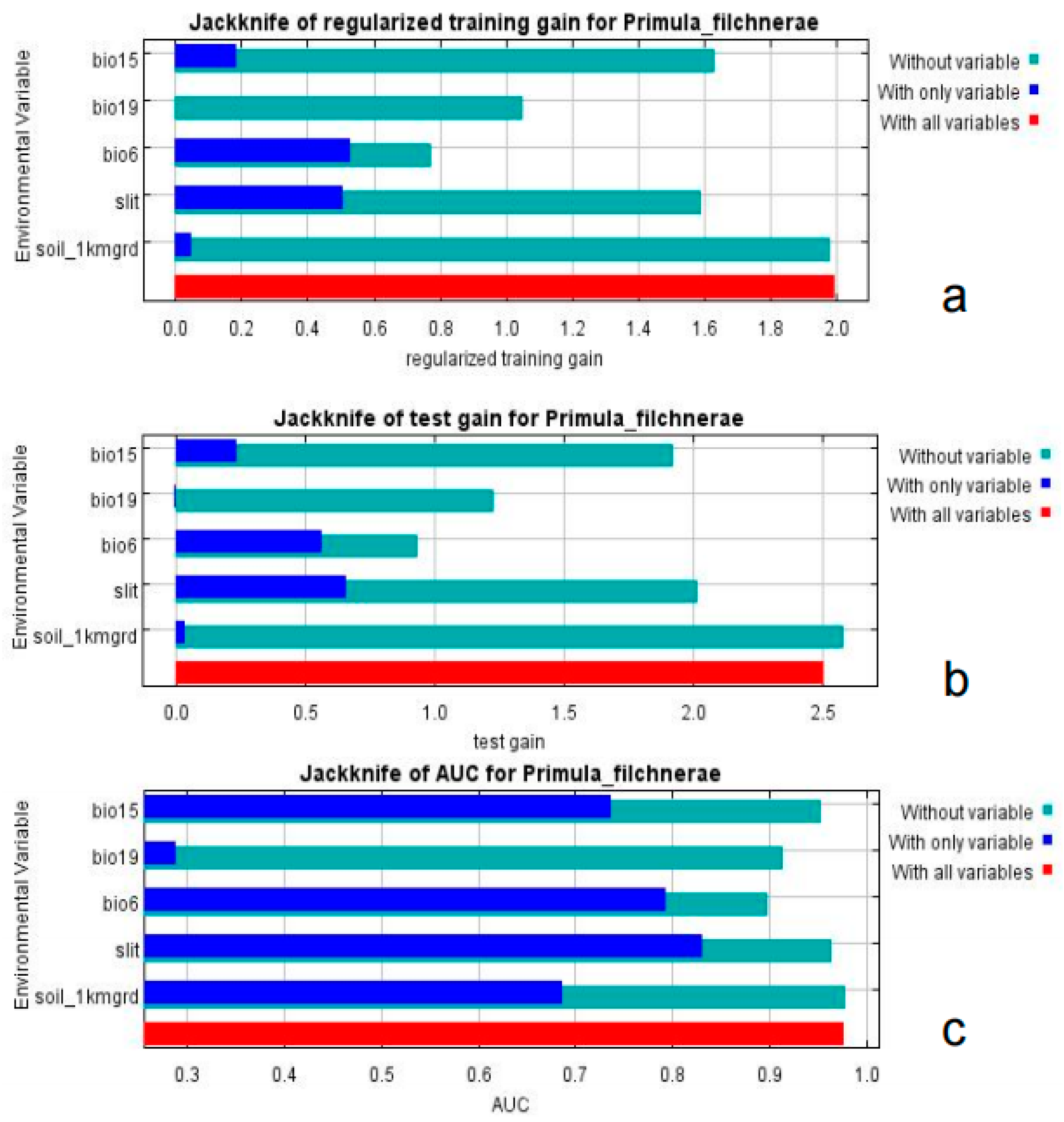

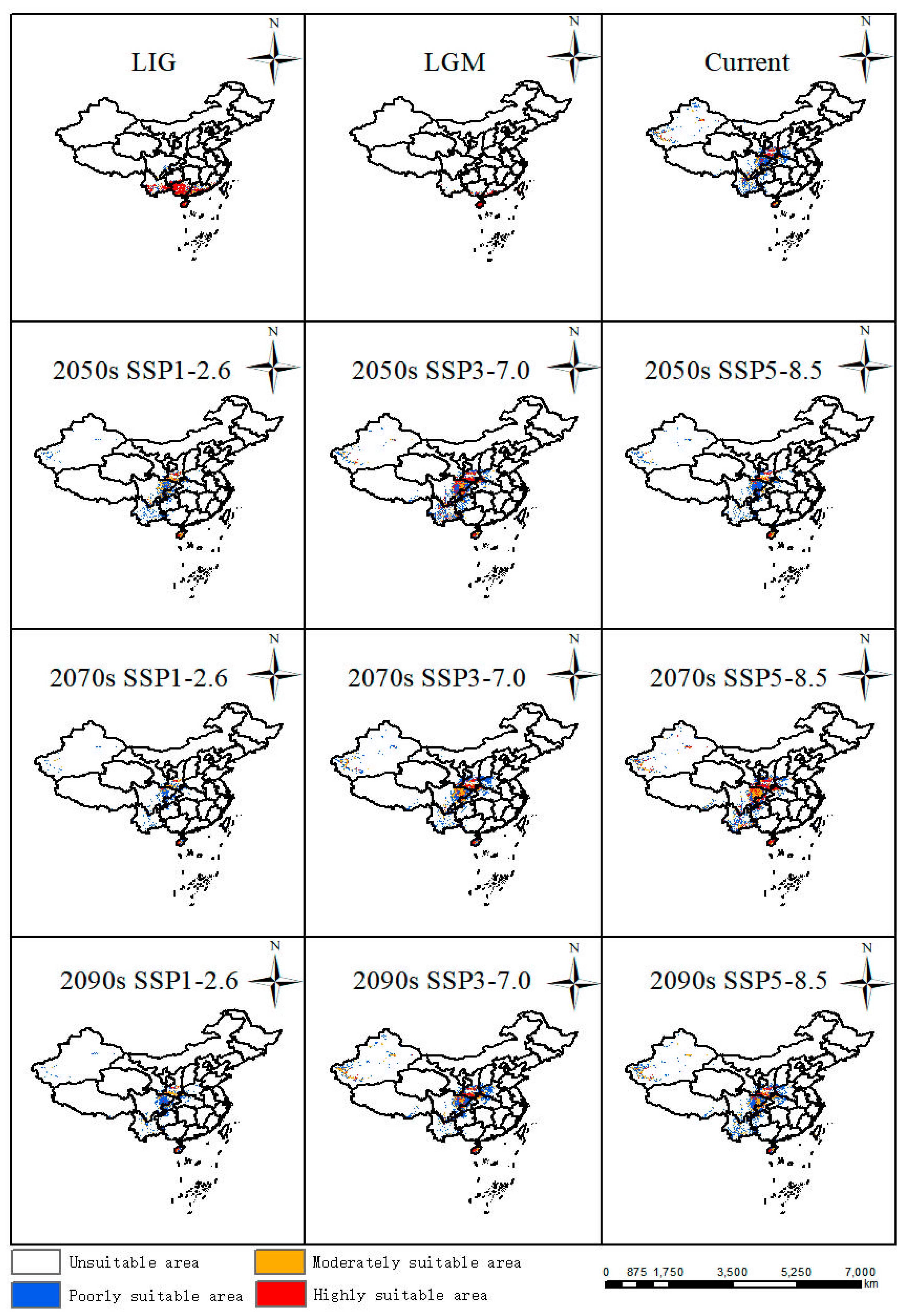
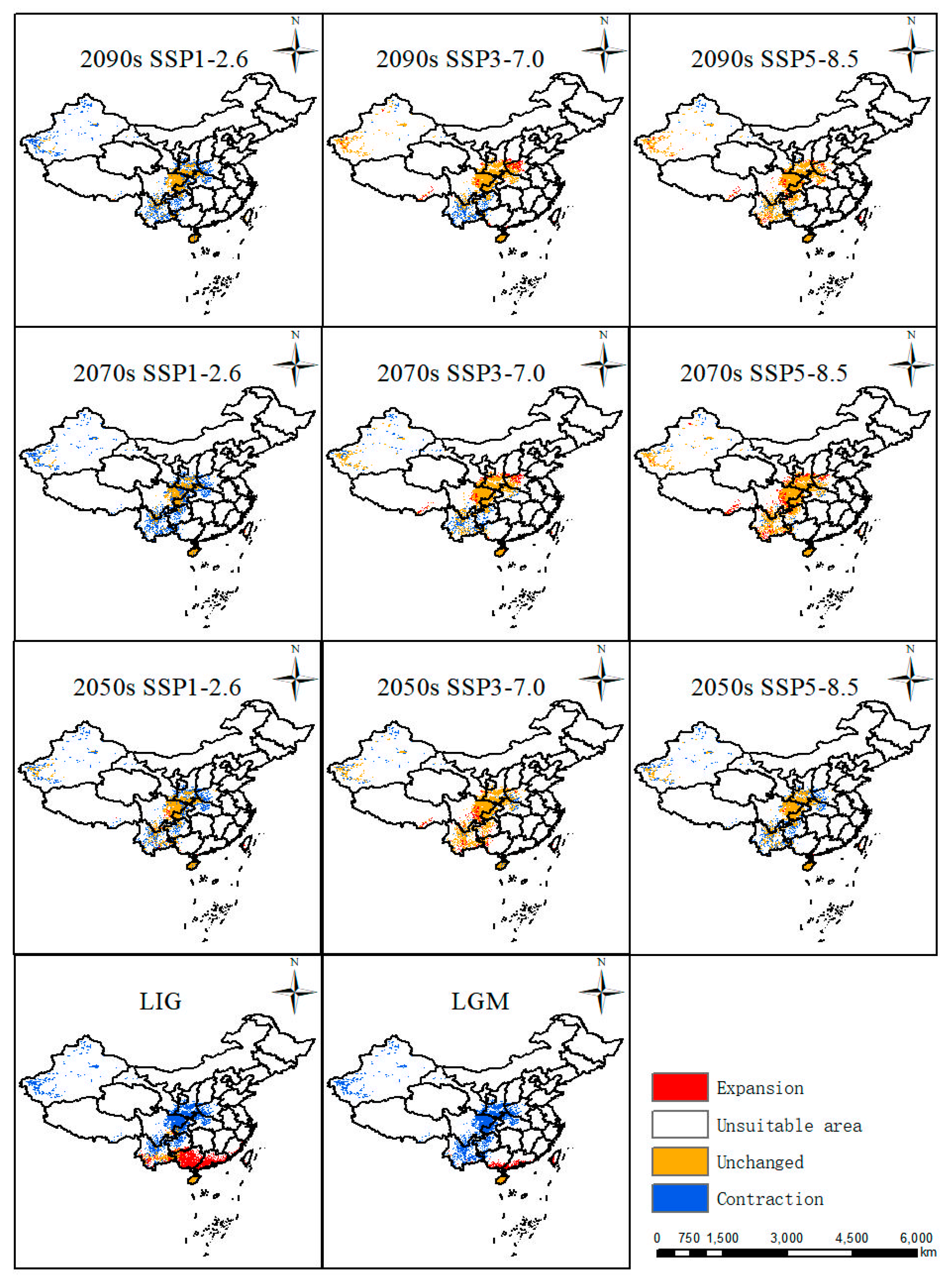
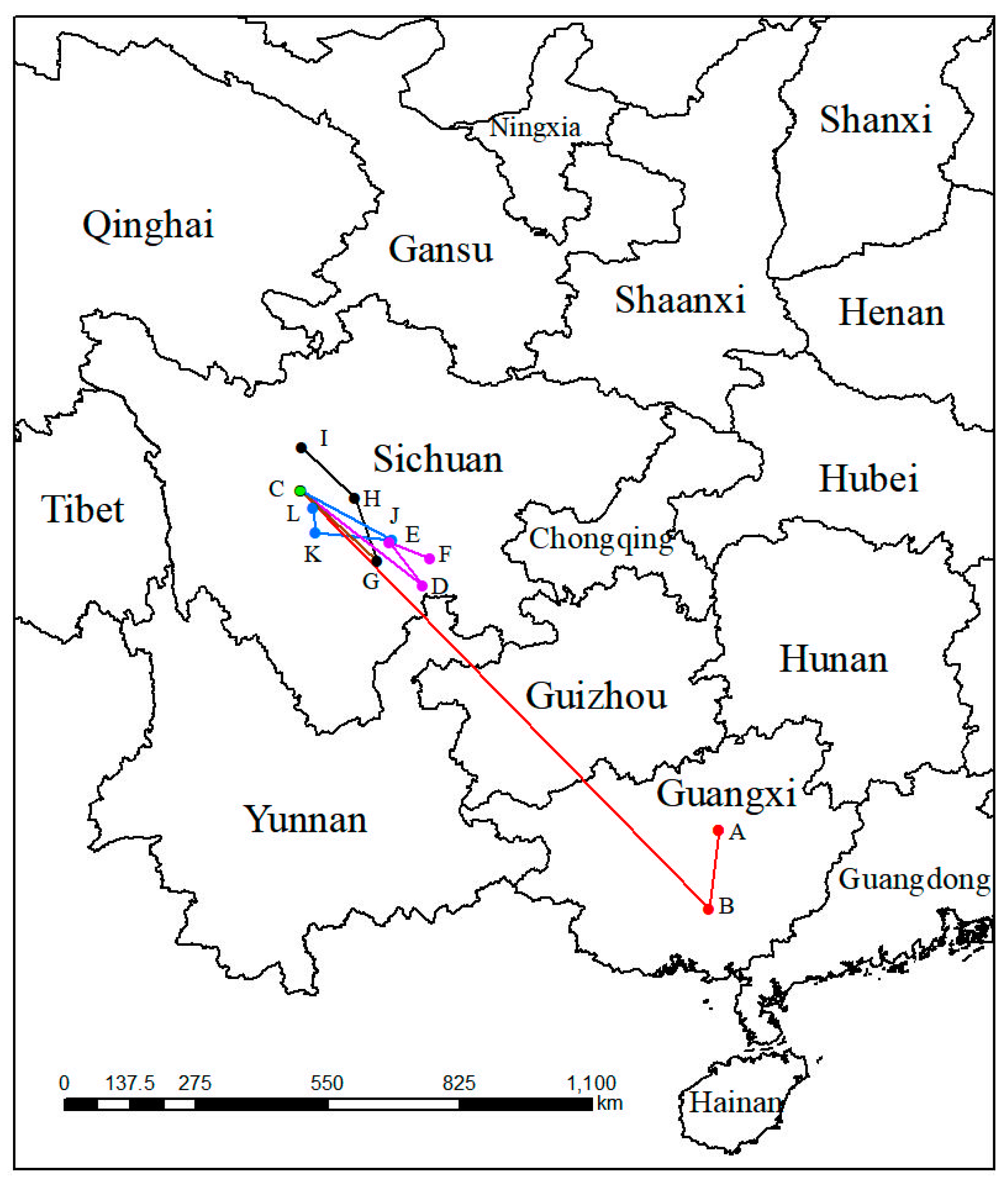
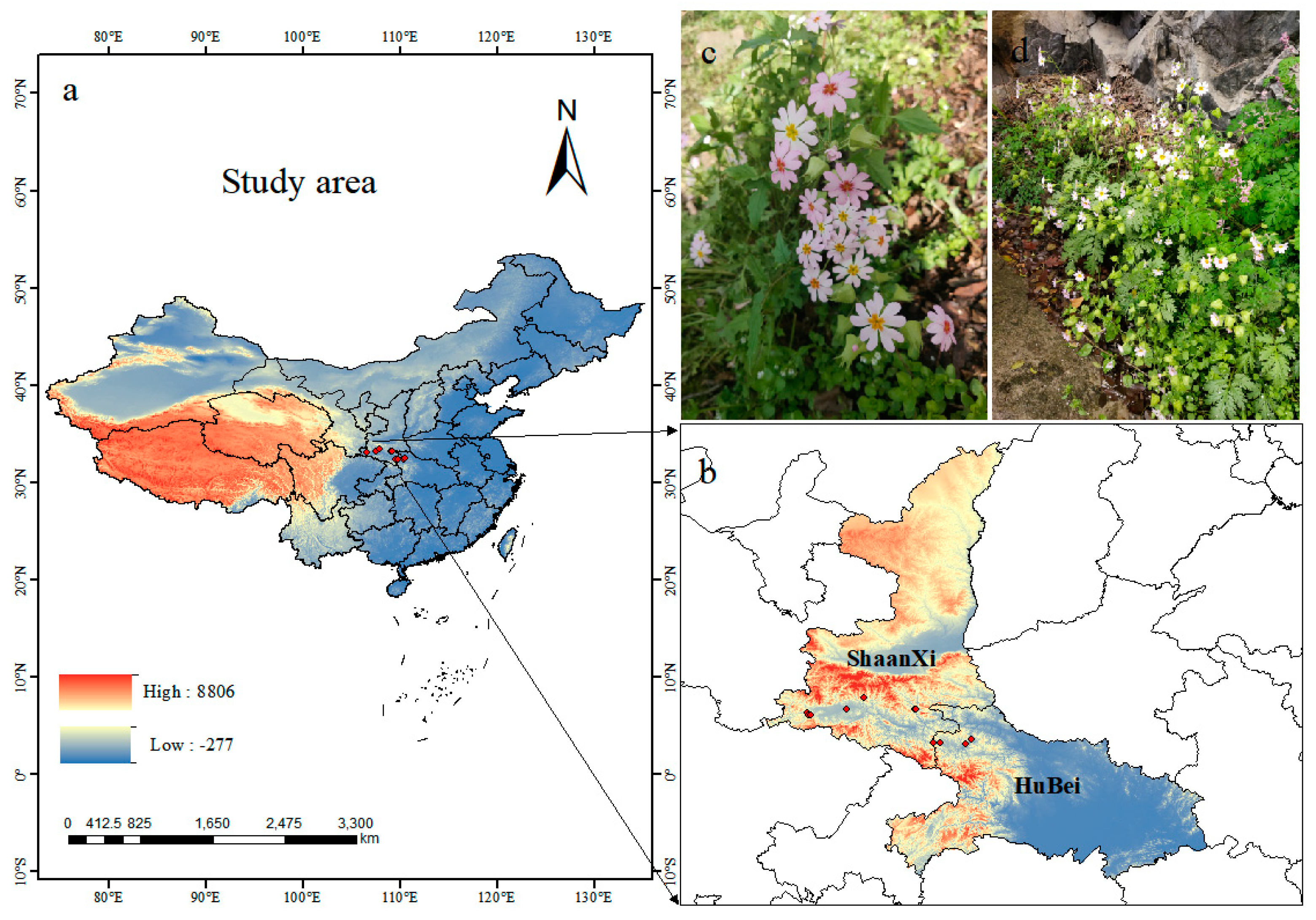
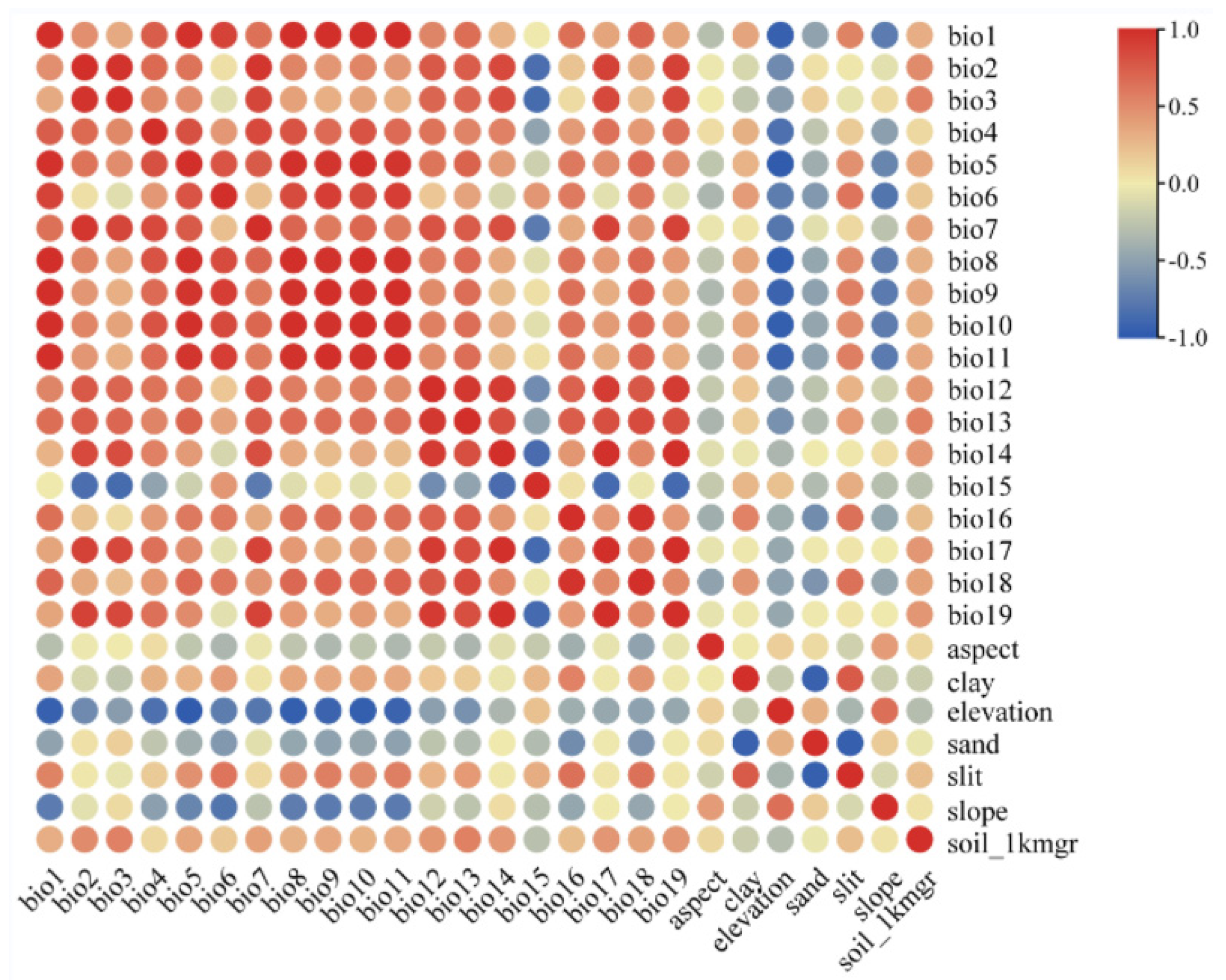
| Period | Total Suitable Area | Unsuitable Area | Poorly Suitable Area | Moderately Suitable Area | Highly Suitable Area |
|---|---|---|---|---|---|
| LIG | 45.38 | 914.62 | 7.00 | 6.89 | 31.48 |
| LGM | 12.73 | 947.27 | 1.85 | 1.8 | 9.09 |
| Current | 70.86 | 889.14 | 44.33 | 17.86 | 8.68 |
| 2050s (SSP1-2.6) | 39.35 | 920.65 | 25.58 | 10.62 | 3.16 |
| 2050s (SSP3-7.0) | 68.41 | 891.59 | 37.09 | 16.24 | 15.08 |
| 2050s (SSP5-8.5) | 45.04 | 914.96 | 28.57 | 11.23 | 5.24 |
| 2070s (SSP1-2.6) | 26.25 | 933.75 | 17.66 | 6.85 | 1.73 |
| 2070s (SSP3-7.0) | 61.26 | 898.74 | 37.44 | 15.51 | 8.31 |
| 2070s (SSP5-8.5) | 79.14 | 880.86 | 36.92 | 21.46 | 20.76 |
| 2090s (SSP1-2.6) | 33.78 | 926.22 | 22.38 | 8.81 | 2.59 |
| 2090s (SSP3-7.0) | 62.30 | 897.70 | 37.82 | 15.40 | 9.09 |
| 2090s (SSP5-8.5) | 71.86 | 888.14 | 43.38 | 19.98 | 8.50 |
| Period | Longitude | Latitude | Migration Direction | Distance (km) | Speed (km/Year) |
|---|---|---|---|---|---|
| LIG | 109.366543 | 24.264458 | LIG-LGM | 167.635 | - |
| LGM | 109.162949 | 22.769528 | LGM-Current | 1217.623 | - |
| Current | 101.509978 | 30.613346 | Current-2050ssp126 | 321.184 | 6.42 |
| 2050s SSP1-2.6 | 103.799766 | 28.849 | 2050ssp126-2070ssp126 | 111.367 | 5.56 |
| 2050s SSP3-7.0 | 102.93946 | 29.294675 | 2070ssp126-2090ssp126 | 89.213 | 4.46 |
| 2050s SSP5-8.5 | 103.220577 | 29.693136 | Current-2050ssp370 | 216.089 | 4.32 |
| 2070s SSP1-2.6 | 103.187339 | 29.642448 | 2050ssp370-2070ssp370 | 138.635 | 6.93 |
| 2070s SSP3-7.0 | 102.530234 | 30.473384 | 2070ssp370-2090ssp370 | 153.850 | 7.69 |
| 2070s SSP5-8.5 | 101.785324 | 29.828095 | Current-2050ssp585 | 215.821 | 4.31 |
| 2090s SSP1-2.6 | 103.93796 | 29.3574 | 2050ssp585-2070ssp585 | 160.174 | 8.00 |
| 2090s SSP3-7.0 | 101.542691 | 31.443977 | 2070ssp585-2090ssp585 | 53.301 | 2.66 |
| 2090s SSP5-8.5 | 101.748686 | 30.306405 |
| Category | Variable | Description | Unit |
|---|---|---|---|
| Climate | bio1 | Annual Mean Temperature | °C |
| bio2 | Mean Diurnal Range (mean of monthly (max temp − min temp)) | °C | |
| bio3 | Isothermality (bio2/bio7) (×100) | / | |
| bio4 | Temperature Seasonality (standard deviation × 100) | / | |
| bio5 | Max Temperature of the Warmest Month | °C | |
| bio6 | Min Temperature of the Coldest Month | °C | |
| bio7 | Temperature Annual Range (bio5–bio6) | °C | |
| bio8 | Mean Temperature of the Wettest Quarter | °C | |
| bio9 | Mean Temperature of the Driest Quarter | °C | |
| bio10 | Mean Temperature of the Warmest Quarter | °C | |
| bio11 | Mean Temperature of the Coldest Quarter | °C | |
| bio12 | Annual Precipitation | mm | |
| bio13 | Precipitation of the Wettest Month | mm | |
| bio14 | Precipitation of the Driest Month | mm | |
| bio15 | Precipitation Seasonality (coefficient of variation) | / | |
| bio16 | Precipitation of the Wettest Quarter | mm | |
| bio17 | Precipitation of the Driest Quarter | mm | |
| bio18 | Precipitation of the Warmest Quarter | mm | |
| bio19 | Precipitation of the Coldest Quarter | mm | |
| Topography | Elevation | m | |
| Slope | ° | ||
| Aspect | rad | ||
| Soil | Clay | % | |
| Sand | % | ||
| Silt | % | ||
| Soil_1kmgrd | Soil types | / |
Disclaimer/Publisher’s Note: The statements, opinions and data contained in all publications are solely those of the individual author(s) and contributor(s) and not of MDPI and/or the editor(s). MDPI and/or the editor(s) disclaim responsibility for any injury to people or property resulting from any ideas, methods, instructions or products referred to in the content. |
© 2023 by the authors. Licensee MDPI, Basel, Switzerland. This article is an open access article distributed under the terms and conditions of the Creative Commons Attribution (CC BY) license (https://creativecommons.org/licenses/by/4.0/).
Share and Cite
Jiang, X.; Liu, W.-J.; Zhu, Y.-Z.; Cao, Y.-T.; Yang, X.-M.; Geng, Y.; Zhang, F.-J.; Sun, R.-Q.; Jia, R.-W.; Yan, C.-L.; et al. Impacts of Climate Changes on Geographic Distribution of Primula filchnerae, an Endangered Herb in China. Plants 2023, 12, 3561. https://doi.org/10.3390/plants12203561
Jiang X, Liu W-J, Zhu Y-Z, Cao Y-T, Yang X-M, Geng Y, Zhang F-J, Sun R-Q, Jia R-W, Yan C-L, et al. Impacts of Climate Changes on Geographic Distribution of Primula filchnerae, an Endangered Herb in China. Plants. 2023; 12(20):3561. https://doi.org/10.3390/plants12203561
Chicago/Turabian StyleJiang, Xin, Wan-Jing Liu, Yan-Zhao Zhu, Yu-Ting Cao, Xiu-Min Yang, Yao Geng, Fu-Jiao Zhang, Rui-Qi Sun, Rui-Wen Jia, Chun-Li Yan, and et al. 2023. "Impacts of Climate Changes on Geographic Distribution of Primula filchnerae, an Endangered Herb in China" Plants 12, no. 20: 3561. https://doi.org/10.3390/plants12203561





